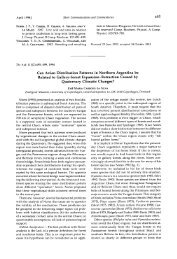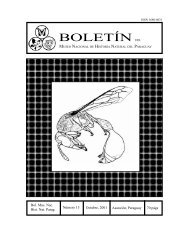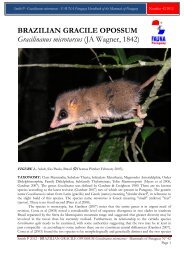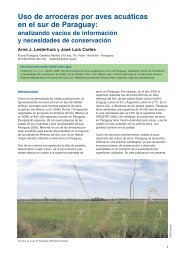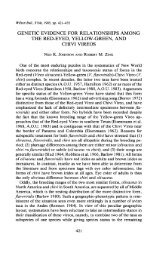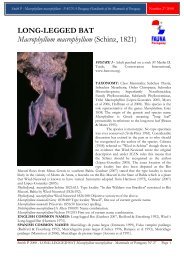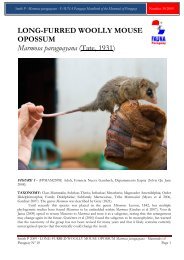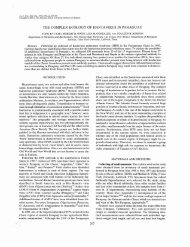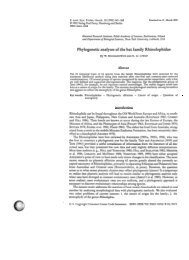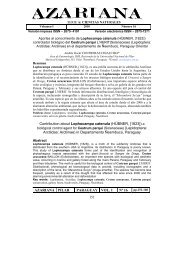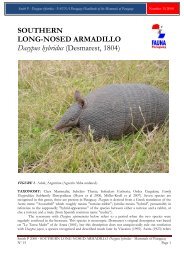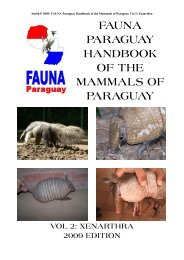A synopsis of the Castniidae (Lepidoptera) of ... - FAUNA Paraguay
A synopsis of the Castniidae (Lepidoptera) of ... - FAUNA Paraguay
A synopsis of the Castniidae (Lepidoptera) of ... - FAUNA Paraguay
Create successful ePaper yourself
Turn your PDF publications into a flip-book with our unique Google optimized e-Paper software.
Zootaxa 3055: 43–61 (2011)<br />
www.mapress.com/zootaxa/ Article<br />
Copyright © 2011 · Magnolia Press<br />
A <strong>synopsis</strong> <strong>of</strong> <strong>the</strong> <strong>Castniidae</strong> (<strong>Lepidoptera</strong>) <strong>of</strong> <strong>Paraguay</strong><br />
Accepted by C. Prieto: 13 Sep. 2011; published: 11 Oct. 2011<br />
ISSN 1175-5326 (print edition)<br />
ZOOTAXA<br />
ISSN 1175-5334 (online edition)<br />
SERGIO D. RÍOS 1,2 & JORGE M. GONZÁLEZ 3<br />
1Museo Nacional de Historia Natural del <strong>Paraguay</strong>, Sucursal 1 Campus, Central XI, San Lorenzo, <strong>Paraguay</strong>.<br />
E-mail: sergiord40@gmail.com<br />
2Departamento de Biología. Facultad de Ciencias Exactas y Naturales. Universidad Nacional de Asunción.<br />
3<br />
Texas A & M University, Department <strong>of</strong> Entomology, College Station, Texas 77843-2475, USA (Research Associate, McGuire Center<br />
for <strong>Lepidoptera</strong> and Biodiversity). E-mail: gonzalez.jorge.m@gmail.com<br />
Abstract<br />
A list with comments on status, natural history, biology, hosts and distribution are presented for all species <strong>of</strong> <strong>Castniidae</strong><br />
known from <strong>Paraguay</strong>. All <strong>the</strong> presented information has been summarized based on literature, museum specimens, information<br />
ga<strong>the</strong>red from researchers/collectors and personal observations. New synonyms are proposed: Imara satrapes catharina<br />
(Preiss) [= Imara satrapes (Kollar)] and Castnia juturna paraguayensis Strand (= Castnia invaria penelope<br />
Schaufuss), and synonymic lists are given in each case. Twelve species are recorded from <strong>Paraguay</strong>, four <strong>of</strong> <strong>the</strong>m are relatively<br />
common and have been previously reported from <strong>the</strong> country [Synpalamides phalaris (Fabricius), Synpalamides<br />
rubrophalaris (Houlbert), Castnia invaria penelope Schaufuss, Gazera heliconioides micha (H. Druce)]. The o<strong>the</strong>r eight<br />
species are much less common in collections [Imara satrapes, Castnia juturna Hopffer, Telchin licus laura (H. Druce),<br />
Ceretes marcelserres (Godart), Riechia acraeoides (Guérin-Méneville), Prome<strong>the</strong>us cochrus (Fabricius), Frostetola<br />
gramivora (Schaus), Paysandisia archon (Burmeister)]. Telchin licus laura (H. Druce) and Frostetola gramivora (Schaus)<br />
are reported from this country for <strong>the</strong> first time. Four species not known from <strong>Paraguay</strong>, but suitable to be found within,<br />
are also mentioned [Yagra fonscolombe (Godart), Castnia lecerfi Dalla Torre, Geyeria uruguayana (Burmeister), Ceretes<br />
thais (Drury)].<br />
Key words: <strong>Paraguay</strong>an Biodiversity, Giant Butterfly-moths, taxonomy, new synonym, <strong>Paraguay</strong><br />
Resumen<br />
Se presenta una lista con comentarios sobre el estado, historia natural, biología, hospederos y distribución para todas las<br />
especies de <strong>Castniidae</strong> conocidas de <strong>Paraguay</strong>. Toda la información provista ha sido recopilada de la literatura, ejemplares<br />
de museos, información obtenida gracias a investigadores/colectores y observaciones personales. Se proponen dos nuevos<br />
sinónimos: Imara satrapes catharina (Preiss) [= Imara satrapes (Kollar)] y Castnia juturna paraguayensis Strand (= Castnia<br />
invaria penelope Schaufuss], y se incluye lista de sinónimos en ambos casos. Doce especies son reconocidas de <strong>Paraguay</strong>,<br />
cuatro de las cuales son relativamente comunes y han sido reportadas anteriormente en el país [Synpalamides<br />
phalaris (Fabricius), Synpalamides rubrophalaris (Houlbert), Castnia invaria penelope Schaufuss, Gazera heliconioides<br />
micha (H. Druce)]. Las restantes ocho especies [Imara satrapes, Castnia juturna Hopffer, Telchin licus laura (H. Druce),<br />
Ceretes marcelserres (Godart), Riechia acraeoides (Guérin-Méneville), Prome<strong>the</strong>us cochrus (Fabricius), Frostetola<br />
gramivora (Schaus), Paysandisia archon (Burmeister)] son menos comunes en colecciones. Telchin licus laura (H. Druce)<br />
y Frostetola gramivora (Schaus) se mencionan por vez primera para el país. Cuatro especies no conocidas de <strong>Paraguay</strong>,<br />
pero posibles de encontrarse, también son reportadas [Yagra fonscolombe (Godart), Castnia lecerfi Dalla Torre, Geyeria<br />
uruguayana (Burmeister), Ceretes thais (Drury)].<br />
Palabras clave: Biodiversidad <strong>Paraguay</strong>a, Taladradores gigantes, taxonomía, nuevo sinónimo, <strong>Paraguay</strong><br />
43
Introduction<br />
Interest on <strong>the</strong> Neotropical <strong>Castniidae</strong> has increased over <strong>the</strong> last 20 years, due to several factors, including <strong>the</strong><br />
introduction <strong>of</strong> a South American species, Paysandisia archon (Burmeister) into Europe, where it has become a<br />
pest <strong>of</strong> relevance on ornamental palms (González & Stünning 2007; Sarto 2002, 2003). The publication <strong>of</strong> two<br />
synonymic checklists, several regional lists and research notes containing information on <strong>the</strong> natural history, biology<br />
and systematics <strong>of</strong> <strong>the</strong> family have contributed largely to improve knowledge and have helped in solving some<br />
<strong>of</strong> <strong>the</strong> taxonomic uncertainties within <strong>the</strong> family (Espinoza & González 2005; González 1997, 2003, 2004; González<br />
& Salazar 2003; González & Stünning 2007; González et al. 2010; Lamas 2004; Moraes 2010, 2011; Sandoval<br />
et al. 2008).<br />
It is well known that <strong>the</strong> giant butterfly-moths (<strong>Castniidae</strong>) are difficult to collect making <strong>the</strong>m usually rare in<br />
insect collections worldwide (Miller 1972, 1976, 1986; González 1999, 2003; González & Fernández Yépez 1992,<br />
1993; González et al. 2006). Besides, several species may be endangered or declining due to native habitat destruction<br />
(González 2004; Lamas 1993). The later appears to be a certain possibility for some <strong>of</strong> <strong>the</strong> <strong>Paraguay</strong>an species.<br />
<strong>Paraguay</strong> is a landlocked South American country bounded by Brazil, Bolivia and Argentina. With a subtropical<br />
climate, it is divided in two large natural regions: The Occidental region, with <strong>the</strong> dry and arid Chaco ecoregion,<br />
in Boquerón and Alto <strong>Paraguay</strong> Departments, and <strong>the</strong> humid Chaco ecoregion, in Presidente Hayes Department;<br />
and <strong>the</strong> Oriental region, more humid, with a mixture <strong>of</strong> various biogeographical regions. This region has been dramatically<br />
deforested since <strong>the</strong> 1970s. The Atlantic Forest which once covered <strong>the</strong> Departments <strong>of</strong> Itapúa, Alto<br />
Paraná, Caaguazú, Caazapá, Guairá and Canindeyú, is now limited to a few patches, almost confined to National<br />
Parks and/or wildlife preserves. The Cerrado ecoregion, in San Pedro, Concepción and Amambay Departments, is<br />
being progressively destroyed, for <strong>the</strong> sake <strong>of</strong> agriculture and raising livestock.<br />
There are very few works with detailed information on <strong>Paraguay</strong>an <strong>Castniidae</strong>, and <strong>the</strong> present contribution<br />
aims to summarize what is known on <strong>the</strong> several species recorded from <strong>the</strong> country as well as those we suspect<br />
might be present.<br />
Material and methods<br />
Selected institutional and private collections mainly from <strong>Paraguay</strong> but also from South-, North America and<br />
Europe containing specimens <strong>of</strong> <strong>Castniidae</strong> were examined. Their codens are as follows:<br />
AMNH American Museum <strong>of</strong> Natural History, New York, New York, USA.<br />
ANSP Academy <strong>of</strong> Natural Sciences, Natural History Museum, Philadelphia, Pennsylvania, USA.<br />
BYU Brigham Young University Insect Collection, Provo, Utah, USA.<br />
CFP Fernando Penco Collection, Morón, Argentina.<br />
CUIC Cornell University Insect Collection, Ithaca, New York, USA.<br />
DZUP Departamento de Zoología, Universidade Federal do Paraná, Curitiba, Paraná, Brasil.<br />
FCA/DE Facultad de Ciencias Agrarias, Departamento de Entomología, Universidad Nacional de Asunción,<br />
San Lorenzo, <strong>Paraguay</strong>.<br />
FMNH Field Museum <strong>of</strong> Natural History, Chicago, Illinois, USA.<br />
FSCA Florida State Collection <strong>of</strong> Arthropods, Gainesville, Florida, USA.<br />
IBIS-UNP Área de Entomología, Instituto de Bioecología e Investigación Subtropical, Universidad Nacional de<br />
Pilar, Ñeembucú, <strong>Paraguay</strong>.<br />
MACN Museo Argentino de Ciencias Naturales “Bernardino Rivadavia”, Buenos Aires, Argentina.<br />
MFS Museo Francisco Schade, Facultad de Ciencias Agrarias, Universidad Nacional de Asunción, San<br />
Lorenzo, <strong>Paraguay</strong>.<br />
MGCL McGuire Center for <strong>Lepidoptera</strong> & Biodiversity, Gainesville, Florida, USA.<br />
MHNP Muséum National d’Histoire Naturelle, Paris, France.<br />
MLP Museo de La Plata, Buenos Aires, Argentina.<br />
MNHNPY Museo Nacional de Historia Natural de <strong>Paraguay</strong> - Inventario Biológico Nacional, San Lorenzo, <strong>Paraguay</strong>.<br />
NHM Natural History Museum, London, United Kingdom.<br />
44 · Zootaxa 3055 © 2011 Magnolia Press<br />
RIOS & GONZALEZ
NHMUM Natural History Museum <strong>of</strong> <strong>the</strong> University <strong>of</strong> Michigan, Ann Arbor, Michigan, USA.<br />
RVC Roberto Vinciguerra Collection, Palermo, Italy.<br />
SMNH Swedish Museum <strong>of</strong> Natural History (Naturhistoriska Riksmuseet), Stockholm, Sweden.<br />
TPC Thierry Porion Collection, Jaujac, France.<br />
FIGURE 1. Map <strong>of</strong> <strong>Paraguay</strong> showing <strong>the</strong> Departments (in capital letters) and localities where <strong>Castniidae</strong> have been collected.<br />
ALTO PARAGUAY: 1. P. N. Defensores del Chaco: Madrejón; PRESIDENTE HAYES: 2. Fortín Nanawa; 33. Costa Esmeralda;<br />
AMAMBAY: 3. P. N. Cerro Corá; SAN PEDRO: 4. Nueva Germania; SAN PEDRO: 5. Molino Cué: 120 km N de Villarrica;<br />
CANINDEYÚ: 6. Villa Ygatimi: Rio Jejui-mi; 7) R.N. Mbaracayú: Lagunita; 8. R.N. Mbaracayú: La Morena;<br />
CENTRAL: 9. Asunción: Loma Pyta; 10. Asunción: Jardín Botánico; 11. Asunción: Barrio Trinidad; 12. San Lorenzo; 13.<br />
Areguá; 14. Ypacarai; CORDILLERA: 15. Atyrá; 16. Caacupé; PARAGUARÍ: 17. Sapucái (Sapucay); 18. Cerro Acahay;<br />
CAAGUAZÚ: 19. San José de los Arroyos; 20. Coronel Oviedo; GUAIRÁ: 21. Mbovevo 22. Colonia Independencia; 23. Villarrica;<br />
24. Cerro Pelado; ALTO PARANÁ: 25. Alto Paraná, Estancia Dimes; 26. Hernandarias; CAAZAPÁ: 27. Tavai, 45 km<br />
E de San Juan Nepomuceno; ITAPÚA: 28. San Rafael, Estancia Nueva Gambach; 29. Puerto San Lorenzo; ÑEEMBUCÚ: 30.<br />
Arroyo Las Hermanas; 31. Paraje Itá Cajón; 32. Arroyo Franco Cué.<br />
Results<br />
The giant butterfly-moths are particularly rare in insect collections and <strong>the</strong> destruction <strong>of</strong> habitats in <strong>Paraguay</strong> is<br />
decreasing <strong>the</strong> possibility <strong>of</strong> recording species/specimens <strong>of</strong> <strong>the</strong> group in <strong>the</strong> country. We have been able to record<br />
twelve species in <strong>the</strong> country based on <strong>the</strong> literature and study <strong>of</strong> <strong>the</strong> insect collections cited above. At least four <strong>of</strong><br />
<strong>the</strong> species [Synpalamides phalaris (Fabricius), S. rubrophalaris (Houlbert), Castnia invaria penelope Schaufuss,<br />
and Gazera heliconioides micha (H. Druce)] appear to be common, especially those with some sort <strong>of</strong> agricultural<br />
CASTNIIDAE OF PARAGUAY<br />
Zootaxa 3055 © 2011 Magnolia Press · 45
pest status. We were unable to find specimens <strong>of</strong> at least two <strong>of</strong> <strong>the</strong> species cited [Ceretes marcelserres (Godart);<br />
Prome<strong>the</strong>us cochrus (Fabricius)] but we list <strong>the</strong>m here because <strong>the</strong>y have been previously collected in <strong>the</strong> country<br />
and reported by reputed entomologists. About nine <strong>of</strong> <strong>the</strong> species listed [Imara satrapes (Kollar), Synpalamides<br />
phalaris (Fabricius), Synpalamides rubrophalaris (Houlbert), Castnia invaria penelope Schaufuss, Castnia juturna<br />
Hopffer, Telchin licus laura (H. Druce), Ceretes marcelserres (Godart), Riechia acraeoides (Guérin-Méneville),<br />
Prome<strong>the</strong>us cochrus (Fabricius) and Frostetola gramivora (Schauss)] are from regions bordering Argentina and/or<br />
Brazil, and even though some <strong>of</strong> <strong>the</strong> specimens collected in <strong>Paraguay</strong> could be part <strong>of</strong> established <strong>Paraguay</strong>an populations<br />
we can not completely rule out <strong>the</strong> possibility that some might have been vagrants from those countries.<br />
Most species mentioned herein have been collected within <strong>the</strong> <strong>Paraguay</strong>an territory, indicating that <strong>the</strong>y might have<br />
well established populations in <strong>the</strong> country (Figure 1). We also include herein some general comments on <strong>the</strong> natural<br />
history and biology <strong>of</strong> <strong>the</strong> species found or recorded, as well as some <strong>of</strong> probable occurrence in <strong>Paraguay</strong>. We<br />
did not provide descriptive notes on each species since <strong>the</strong>y will be easily identified from figures 2–19.<br />
Imara satrapes (Kollar, 1839)<br />
(Fig. 2)<br />
Castnia satrapes Kollar, 1839<br />
Castnia catharina Preiss, 1899<br />
Castnia satrapes f. aberrans Strand, 1913<br />
Castnia satrapes f. rufimaculata Strand, 1913<br />
Castnia satrapes f. sapucaya Jörgensen, 1930<br />
Castnia satrapes var. pomposa Niepelt, 1932<br />
Castnia satrapes insolita Schweiser & Kay, 1941<br />
Castnia sapuca J.Y.Miller, 1995, missp.<br />
Imara satrapes catharina Lamas, 1995, n. syn.<br />
Taxonomic history. Preiss (1899) described <strong>the</strong> subspecies catharina (as Castnia catharina) based on color differences<br />
with <strong>the</strong> nominate subspecies and illustrated a female with a band <strong>of</strong> red spots on <strong>the</strong> hind wings which are<br />
not present in <strong>the</strong> material later studied by Strand (1913). Strand (1913) states this particular subspecies differs<br />
from <strong>the</strong> nominate one in having a hindwing median band “light yellow instead <strong>of</strong> orange”. He also mentions that<br />
<strong>the</strong> red spots could be a sexual difference present always in females but only occasionally in males (Strand 1913).<br />
Jörgensen (1930) reports that this is a rare subspecies but few specimens were collected by Höhn in <strong>the</strong> forests <strong>of</strong><br />
Mbuvevo, Guairá Department. Breyer (1935) mentions that he collected catharina in Puerto Aguirre, Misiones,<br />
Argentina. Jörgensen (1930) described also <strong>the</strong> new form sapucaya based on a specimen collected by Heinrich in<br />
Sapucay, Paraguarí Department. Miller (1986, 1995) does not consider sapucaya [erroneously mentioned as<br />
sapuca in Miller (1995)] and catharina as valid subspecies placing <strong>the</strong>m as synonyms. The topotype <strong>of</strong> Castnia<br />
satrapes is Brasil, Mato Grosso, [Vila Bela da Santíssima Trindade], [15º00'S, 59º57'W, 200m], west <strong>of</strong> Cuiabá and<br />
north <strong>of</strong> Pantanal, far from <strong>the</strong> locality from where f. catharina (Rio Grande do Sul) was described. Based on that<br />
premise (Lamas, pers. comm.), Lamas (1995) reinstated catharina as a valid subspecies while considering sapucaya<br />
a synonym <strong>of</strong> I. satrapes. The hindwing coloration <strong>of</strong> Imara satrapes is highly variable, and we do not see<br />
much sense in considering <strong>the</strong> Santa Catharina, Brazil and <strong>Paraguay</strong> specimens as a separate subspecies. Fur<strong>the</strong>rmore,<br />
Miller (1986; pers. comm.) studied large series <strong>of</strong> I. satrapes which allowed her to notice how variable <strong>the</strong><br />
species is and also to include catharina as synonym, thus we prefer to follow Miller (1986, 1995) on this regard<br />
and consider Imara satrapes catharina as new synonym <strong>of</strong> I. satrapes until a more detailed study indicates<br />
o<strong>the</strong>rwise.<br />
Distribution. This species is known to be sympatric with Imara pallasia (Eschscholtz, 1821). They are both<br />
commonly found in <strong>the</strong> sou<strong>the</strong>astern region <strong>of</strong> Brazil and even though <strong>the</strong> color pattern <strong>of</strong> <strong>the</strong>ir forewings are quite<br />
different, <strong>the</strong>ir hindwings are highly variable and in cases might be sligthly similar to each o<strong>the</strong>r (Miller 1986).<br />
Even though we were able to examine just a few specimens from <strong>Paraguay</strong>, many have been collected and/or<br />
mentioned by a few authors in <strong>the</strong> past. Does this mean that <strong>the</strong> species used to be more common? Or is it just that<br />
collectors and entomologists have not been able to determine locations and/or times where adults emerge and fly?<br />
Biology and behavior. Jörgensen (1930) mentions that it frequently flies in <strong>Paraguay</strong> around plants <strong>of</strong> “Caraguatá”<br />
(Bromeliaceae: Bromelia spp.?, Caraguata spp.?, Pseudananas spp.? ). Miller (1986) mentions that she<br />
46 · Zootaxa 3055 © 2011 Magnolia Press<br />
RIOS & GONZALEZ
found at <strong>the</strong> Museu Nacional-Rio de Janeiro, Brazil, a pupal skin with a label stating that it was found in Bromelia<br />
simour (an unknown plant species name, as far as we know. It might have been an erroneous translitteration) while<br />
an intact pupa had a label reading only “Bromeliaceae”. Biezanko (1961b) mentions that <strong>the</strong> larva <strong>of</strong> this species<br />
feeds on Bromelia fastuosa Lindl. (Bromeliaceae). This species has been recorded flying high (over 10 m above<br />
ground) normally at mid-day (11:00–15:00) from November to February in Brazilian lowland and/or cloud forests<br />
(Miller 1986, Biezanko 1961a).<br />
Material examined. GUAIRÁ: 1♀, “<strong>Paraguay</strong>. Villarica”, A. Breyer Collection (MLP). ITAPÚA: 1♂, Estancia<br />
Nueva Gambach , 26°25´S, 55°40´W. 21.XII.2008 (MNHNPY). ALTO PARANÁ: 1♂, Estancia Dimes<br />
25°33’S, 55°13’W. 19–23.XII.2005. Coll. U. Drechsel (MNHNPY);<br />
Synpalamides phalaris (Fabricius, 1793)<br />
(Fig. 3)<br />
Papilio phalaris Fabricius, 1793<br />
Taxonomic history. Druce (1896) described Castnia sora separating it from Castnia mygdon Dalman, 1824 (a<br />
junior subjective synonym <strong>of</strong> phalaris) basically by being darker. The description <strong>of</strong> <strong>the</strong> species is based on two<br />
specimens collected in San José, Caaguazú department, <strong>Paraguay</strong>. Strand (1913) clearly follows Druce (1896) and<br />
keeps <strong>the</strong> species as valid. Houlbert (1918) place Castnia sora in <strong>the</strong> genus Sympalamides[sic]. Talbot (1919) mentions<br />
that <strong>the</strong> type <strong>of</strong> Sympalamides[sic] sora is “a red form <strong>of</strong> mimon Hübner”. Lathy (1922) reports <strong>the</strong> species, as<br />
Sympalamides[sic] phalaris sora from Sapucay, <strong>Paraguay</strong>, in Fournier’s collection. Jörgensen (1930) reports <strong>the</strong><br />
rare presence <strong>of</strong> Castnia (Sympalamides)[sic] phalaris sora from Trinidad (Central Department), Sapucay (Paraguarí<br />
Department), Molino Cué, 120 km north <strong>of</strong> Villarrica (Guairá Department). He also mentions that <strong>the</strong> species<br />
was observed in large numbers by Schade (Jörgensen, 1930). Miller (1986, 1995) keeps <strong>the</strong> species as Synpalamides<br />
sora while Lamas (1995) placed sora as a synonym <strong>of</strong> phalaris. Benítez (1988, 2002) mentions <strong>the</strong> presence<br />
<strong>of</strong> <strong>the</strong> species, as Castnia sara[sic], in <strong>the</strong> Collection <strong>of</strong> <strong>the</strong> Department <strong>of</strong> Entomology at Universidad<br />
Nacional de Asunción. Back in November 2009, A. Contreras (pers. comm.) photographed a single specimen from<br />
Arroyo Las Hermanas, Ñeembucú Department, flying low and slowly alongside several Castnia invaria penelope,<br />
in an open area, densely covered with Bromelia spp. Even though Miller (1986) mentions that this is a highly variable<br />
species, she keeps several taxa as valid (Miller 1995) which were later synonymized by Lamas (1995). We suggest<br />
that Synpalamides orestes (Walker), Synpalamides phalaris (Fabricius) and Synpalamides rubrophalaris<br />
(Houlbert) could possibly represent stages <strong>of</strong> a morphological cline. Lamas (pers. comm.) agrees with us in this<br />
respect. However, only an in depth morphological study <strong>of</strong> large series <strong>of</strong> <strong>the</strong> many “forms” <strong>of</strong> those three species<br />
will allow to discern if <strong>the</strong>re is a geographic correlation with <strong>the</strong> several known phenotypes.<br />
Distribution. It has been reported from Brazil. Uruguay, and <strong>Paraguay</strong>, and specimens are known suposedly<br />
collected in Argentina (González & Cock 2004; González & Stünning 2007; González et al. 2010; Lamas 1995;<br />
Lathy 1922, 1923; Miller 1986, 1995).<br />
Biology and behavior. Benítez (2002) mentions this species associated with pineapple (Ananas sp.? or Pseudananas<br />
sp.?) and bananas (Musa sp.). Jörgensen (1930) states that <strong>the</strong> species flies during November and December<br />
around plants <strong>of</strong> “Caraguatá” [Bromelia balansae Mez and Pseudananas sagenarius var. macrodontes (E.<br />
Morren) Camargo]. There is not much known about <strong>the</strong> life history <strong>of</strong> this species, however, females have been<br />
observed laying eggs on Guzmania sp. and Bromelia sp. (Bromeliaceae) (Miller 1986). It has been seen flying in<br />
forest clearings during January and February in certain areas <strong>of</strong> Brazil (Biezanko 1961b).<br />
Material examined. PARAGUARÍ: 1♂, Cerro Acahay. 2.XI.1991. Coll. C. Aguilar [collected in lowland Forest]<br />
(MNHNPY); 1♂, “Castnia sora Druce”, “Sympalamides[sic] sora Druce”, “<strong>Paraguay</strong>, Sapucay, 2.XII.1903,<br />
W.Foster ,1903–138”, “Collection Wm. Schaus” (MGCL). CENTRAL: 1♂, Asunción. Stma. Trinidad.<br />
23.XII.1940 (FCA/DE); 1♀, [Asunción], Jardín Botánico, 28.XI.1955 (MFS). CAAGUAZÚ: 1♂, [Type <strong>of</strong> Castnia<br />
sora], “Type”, “Castnia sora Druce”, “Castnia sora ♂ type Druce”, “San José, <strong>Paraguay</strong>, R. Perrens”, “Ex.<br />
Coll. Herbert Druce 1913”, “Joicey Bequest., Brit. Mus. 1934–120.” (NHM, from a photograph provided by Dr. G.<br />
Lamas).<br />
CASTNIIDAE OF PARAGUAY<br />
Zootaxa 3055 © 2011 Magnolia Press · 47
FIGURES 2–9. Adults <strong>of</strong> <strong>Castniidae</strong>. 2. Imara satrapes Kollar, ♂, Itapúa, <strong>Paraguay</strong> (MNHNPY); 3. Synpalamides phalaris<br />
(Fabricius), ♂, Asunción, <strong>Paraguay</strong> (FCA/DE); 4. Synpalamides rubrophalaris (Houlbert), ♂, Alto Paraná, <strong>Paraguay</strong><br />
(MNHNPY); 5. Castnia invaria penelope Schaufuss (White morph), ♂, Sapucay, <strong>Paraguay</strong> (MGCL); 6. Castnia invaria penelope<br />
Schaufuss (red morph), ♂, Ypacaraí, <strong>Paraguay</strong> (FCA/DE); 7. Castnia juturna Hopffer, ♂, Argentina (MACN); 8. Telchin<br />
licus laura (H. Druce), ♂, Canindeyú, <strong>Paraguay</strong> (MNHNPY); 9. Riechia acraeoides (Guérin-Méneville), ♂, Asunción, <strong>Paraguay</strong><br />
(MNHNPY).<br />
48 · Zootaxa 3055 © 2011 Magnolia Press<br />
RIOS & GONZALEZ
Synpalamides rubrophalaris (Houlbert, 1917)<br />
(Fig. 4)<br />
Castnia rubrophalaris Houlbert, 1917<br />
Taxonomic history. Typical specimens <strong>of</strong> his species can be easily distinguished from typical Synpalamides<br />
phalaris based mainly in color differences. It was originally described by Houlbert (1917) from Brazil, Bahia as<br />
Castnia rubrophalaris. It was later placed in <strong>the</strong> genus Sympalamides[sic] (Houlbert 1918). Rothschild (1919)<br />
mentions <strong>the</strong> species [as Castnia (Sympalamides[sic]) mygdon form rubrophalaris Houlbert) collected in November,<br />
1903, from Sapucay, <strong>Paraguay</strong>.<br />
Distribution. The species is distributed in Sou<strong>the</strong>rn Brazil, but reaches <strong>Paraguay</strong>, however <strong>the</strong>re is a report <strong>of</strong><br />
at least one specimen supposedly collected in Venezuela (Joicey & Talbot, 1925; Lamas 1995; Miller 1986, 1995)<br />
Biology and behavior. It has been collected in Atlantic Forest in <strong>the</strong> areas <strong>of</strong> occurrence in <strong>Paraguay</strong>, where it<br />
is possible to find specimens perching on leaves <strong>of</strong> bushes or small size plants (Fig. 21). Ulf Drechsel (pers.<br />
comm.) mentions that Synpalamides rubrophalaris is relatively common in <strong>the</strong> Atlantic Forest <strong>of</strong> <strong>the</strong> Alto Paraná<br />
Department. The hosts are Unknown.<br />
Material examined. 1♂, Castnia sora–Druce–(mpd.B.h (<strong>Paraguay</strong>) (Slide M-2557, Jacqueline Y. Miller)<br />
(MGCL). PARAGUARÍ: 1♂, (232), Sapucay, <strong>Paraguay</strong>, 10.11.04, (Slide M-2558, Jacqueline Y. Miller) (MGCL).<br />
ALTO PARANÁ: 1♂, Estancia Dimes, 25°33’S, 55°13’W. 19–23.XII.2005. Coll. U. Drechsel (MNHNPY). CAN-<br />
INDEYÚ: 1♀, Reserva de Mbaracayú, Puesto La Morena. 6–8.XI.1991. Coll. C. Aguilar & J. Kochalka [Collected<br />
inside Forested area] (MNHNPY); 1♂ Distrito Ygatimi: Río Jejui-mí, 7.XI.1998 (IBIS-UNP).<br />
Castnia invaria penelope Schaufuss, 1870<br />
(Figs. 5–6)<br />
Castnia penelope Schaufuss, 1870<br />
Castnia endelechia H. Druce, 1893<br />
Castnia juturna f. paraguayensis Strand, 1913, n.syn.<br />
Castnia icaroides Houlbert, 1917<br />
Castnia jordani Houlbert, 1917<br />
Castnia (Elina) icarus penelope ab. endelechiodes Rothschild, 1919<br />
Castnia minerva R. Krüger, 1926<br />
Castnia icarus dividuus Röber, 1928<br />
Castnia (Elvina[sic]) icarus f. hoehni Jörgensen, 1930<br />
Castnia icarus patquiensis Breyer, 1943<br />
Castnia endelechoides J.Y. Miller, 1995, missp.<br />
Castnia icarioides J.Y.Miller, 1995, missp.<br />
Taxonomic history. Jörgensen (1930) lists three subspecies under “Castnia icarus” which were later synonymized<br />
under Castnia invaria penelope by Lamas (1995). One <strong>of</strong> those is endelechia Druce, mentioned as abundant in<br />
Nor<strong>the</strong>rn Argentina and in several locations in <strong>Paraguay</strong> (Jörgensen 1930). Breyer (1940) corroborates that endelechia<br />
is common in <strong>Paraguay</strong>. Krüger (1926) described specimens from Puerto San Lorenzo (Itapúa Department) as<br />
Castnia minerva. Krüger’s new species was later synonymized under C. invaria penelope (Lamas 1995). Jörgensen<br />
(1930) also described <strong>the</strong> form hoehni (= C. invaria penelope) from Nueva Germania (San Pedro Department)<br />
where Höhn, in whose honor was named, “found it abundantly”. Jörgensen (1930) also lists invaria Walker, as a<br />
rare find, collected in November and December in open fields in San Bernardino (Cordillera), Sapucay (Paraguarí)<br />
and Mbuvevo (Guairá). Castnia invaria invaria was originally described from, and appears to be restricted to Rio<br />
de Janeiro, in Sou<strong>the</strong>ast Brazil (Walker 1854; Houlbert 1918, Miller 1986, 1995, Lamas 1995). It also appears that<br />
<strong>the</strong> taxa described as endelechia Druce, endelechoides Rothschild, patquiensis Breyer, and paraguayensis Strand,<br />
might be phenotypes related to areas where <strong>the</strong> microclimates and potential hostplants are strikingly different from<br />
<strong>the</strong> areas where <strong>the</strong> “reddish” phenotypes <strong>of</strong> C. invaria penelope are found. Castnia jordani Houlbert, could be an<br />
intermediate phenotype between those found in both regions. Castnia minerva Krüger appears to represent a “connection”<br />
to Castnia lecerfi Dalla Torre, (fig. 17) so <strong>the</strong> latter might be considered as a synonym <strong>of</strong> C. invaria pene-<br />
CASTNIIDAE OF PARAGUAY<br />
Zootaxa 3055 © 2011 Magnolia Press · 49
lope as well. It is quite clear that a large series <strong>of</strong> specimens <strong>of</strong> <strong>the</strong> different phenotypes from <strong>the</strong> entire recorded<br />
geographic distribution is required in order to assess <strong>the</strong> validity <strong>of</strong> <strong>the</strong> proposed names <strong>of</strong> most species/subspecies.<br />
Distribution. This subspecies is widely distributed in Brazil, south <strong>of</strong> <strong>the</strong> Amazon River, and reaches Argentina,<br />
Bolivia and <strong>Paraguay</strong> (González & Stünning 2007).<br />
Biology and behavior. It is a highly variable subspecies and several “color” morphs are known to occur<br />
toge<strong>the</strong>r (Jordan 1906; González & Stünning 2007). Jörgensen (1930) collected several specimens in various locations<br />
in <strong>Paraguay</strong> including San Bernardino, Sapucay, Villarrica and Mbovevo which are in Cordillera, Paraguarí<br />
and Guairá Departments. He also mentions that this castniid could be found from November to January in any site<br />
where “caraguatás” (Bromeliaceae) were abundant.<br />
We were able to collect one specimen <strong>of</strong> this subspecies from Cerro Corá, Amambay Department, in late October;<br />
<strong>the</strong>re <strong>the</strong> first author saw groups <strong>of</strong> at least 10 different individuals flying fast, from 11:00 to 14:00 hs., over<br />
open spaces in an area covered with Bromelia balansae Mez. Ulf Drechsel (pers. comm.) reports <strong>the</strong> same behavior<br />
in Costa Esmeralda, Presidente Hayes Department, where he saw “numerous females, all <strong>of</strong> <strong>the</strong> white morph, flying<br />
over dense stockings <strong>of</strong> Bromelia serra, B. hieronymi and Aechmea distichantha in <strong>the</strong> Chaco thornbush, but<br />
laying eggs only on <strong>the</strong> base <strong>of</strong> B. hieronymi”.<br />
Rothschild (1919) mentions that <strong>the</strong> Tring Museum (now at NHM) had 8 ♂♂, 2♀♀ from Sapucay nr. Villa<br />
Rica, <strong>Paraguay</strong>, collected between November and December during <strong>the</strong> years 1902 to 1904 by W. Foster, as well as<br />
2 ♂♂?, 1♂, from <strong>Paraguay</strong> but no fur<strong>the</strong>r details are given.<br />
It has been found in <strong>Paraguay</strong> attacking Bromelia balansae Mez and Ananas macrodontes E. Morren (Jörgensen,1930).<br />
The species is also known as a minor pest <strong>of</strong> pineapples [Ananas comosus (L.) Merr.] in several regions<br />
<strong>of</strong> South America (González & Stünning 2007; Miller 1986) including <strong>Paraguay</strong>. Pastrana (2004) mentions Aechmea<br />
sp., as host for “Castnia elina”, and Bromelia serra Griseb, as host for Castnia endelechia (and citing Jörgensen<br />
1930), in Argentina.<br />
Material examined. GUAIRÁ: 3♂♂, “<strong>Paraguay</strong>, Independencia” A. Breyer Collection (MLP). PARA-<br />
GUARÍ: 1♂, Sapucay, <strong>Paraguay</strong>, 25.12.[19]04, (genitalia vial no. M-3750, Jacqueline Y. Miller) (MGCL); 1♂,<br />
Sapucay, <strong>Paraguay</strong>, Ex. Coll. Herbert Druce, 1913, (Slide No. M-3033, Jacqueline Y. Miller) (MGCL); 1♂, Sapucay,<br />
16.12.04 (MGCL); 1♂, Sapucay, n. Villa Rica, Nov. 02 (Foster), R304/23, (Slide No. M-7103, Jacqueline Y.<br />
Miller) (MGCL); 1♂, [Type <strong>of</strong> Castnia endelechia jordani Houlbert, 1918], Sapucay, <strong>Paraguay</strong>, 20.XI.[19]03, W.<br />
Foster, “Nov. Zool. 1906. Pl. 10, Fig. 3”, “endelechia f. jordani Houlbert” (NHM, from a photograph provided by<br />
Dr. G. Lamas). CENTRAL: 1♂, Ypacarai, 18.XI.1968 (FCA/DE); 1♂, [Asunción], Jardín Botánico, 28.XI.1955<br />
(MFS); ÑEEMBUCÚ: 4♂♂, Distrito Tacuaras, Arroyo Las Hermanas. 26.XI.2009. Coll A. Contreras (IBIS-<br />
UNP). CANINDEYÚ: 1♂, Reserva de Mbaracayú, Puesto Lagunita. 9.XI.1991. Coll. A. Fleitas (MNHNPY) [Collected<br />
in a forest near <strong>the</strong> building <strong>of</strong> Puesto Lagunita]. ALTO PARAGUAY: 1♀, Parque Nacional Defensores del<br />
Chaco: Madrejón, 15–16.XII.1982. Coll. J. Kochalka (MNHNPY), <strong>the</strong> specimen was collected sleeping under a<br />
Bromelia sp. leaf.<br />
Castnia juturna Hopffer, 1856<br />
(Fig. 7)<br />
Taxonomic history. The species was originally described from Brazil by Hopffer (1856). Preiss (1899) mentions<br />
<strong>the</strong> species (erroneously as Castnia inturna in <strong>the</strong> text, but correctly in <strong>the</strong> included plate) from Rio Grande do Sul,<br />
Brazil. Burmeister (1879) confirms <strong>the</strong> presence <strong>of</strong> <strong>the</strong> species in <strong>Paraguay</strong>, but says that it is smaller than <strong>the</strong><br />
Argentinian specimens and that <strong>the</strong> black marginal band <strong>of</strong> <strong>the</strong> hindwings is interrupted by two rows <strong>of</strong> white rededged<br />
spots which are parallel to <strong>the</strong> margin. This “<strong>Paraguay</strong>an form” was later named paraguayensis by Strand<br />
(1913). After carefully studying <strong>the</strong> available literature and information on this and similar species, as well as discussions<br />
with experts on <strong>the</strong> group, we now consider that paraguayensis should be regarded as a new synonym <strong>of</strong><br />
Castnia invaria penelope, and not <strong>of</strong> Castnia juturna. Krüger (1928) described <strong>the</strong> variety vesta from Cerro Pelado<br />
in <strong>the</strong> Guairá Department, <strong>Paraguay</strong>. Jörgensen (1930) mentions that he never saw a specimen from <strong>Paraguay</strong> but<br />
he observed <strong>the</strong>m in at least one site in Argentina. He also thought that he confused form vesta with paraguayensis<br />
(“… esta forma [vesta] que he tomado por paraguayensis …”) around Cerro Pelado, Guairá Department, in <strong>the</strong><br />
Cordillera <strong>of</strong> Villarrica (Jörgensen 1930).<br />
50 · Zootaxa 3055 © 2011 Magnolia Press<br />
RIOS & GONZALEZ
Distribution. Known from Nor<strong>the</strong>rn Argentina, South East Brazil and Eastern <strong>Paraguay</strong> (Miller 1986).<br />
Biology and behavior. Specimens were seen flying around Dyckia floribunda Griseb. (Bromeliaceae) in <strong>the</strong><br />
Colonia Bompland region <strong>of</strong> Misiones, Argentina, and around Dyckia distachya fa. induta Hassl. (mentioned as<br />
Dyckia microcalyx) in <strong>the</strong> Villarrica region <strong>of</strong> <strong>Paraguay</strong> (Jörgensen 1930).<br />
Material examined. 1♂, Paraguai, 3.XII.1927, Ex-col. Gagarin.(DZUP). GUAIRÁ: 1♂, “Cerro Pelado”, A.<br />
Breyer Collection (MLP).<br />
Telchin licus laura (H. Druce, 1896)<br />
(Fig. 8)<br />
Castnia laura H. Druce , 1896<br />
Taxonomic history. The ssp. was originally described (as Castnia laura) by Herbert Druce (1896). Miller (1995)<br />
considered it a synonym <strong>of</strong> Leucocastnia licus (Drury) and Lamas (1995) placed it as a ssp. <strong>of</strong> Telchin licus (Drury)<br />
. Benítez (2002) mentions Castnia sora (= Synpalamides phalaris) and Castnia licus in his list <strong>of</strong> forest and agricultural<br />
pests <strong>of</strong> <strong>Paraguay</strong> based on specimens deposited at <strong>the</strong> FCA/DE. The first author visited this collection in<br />
2009 and only saw specimens <strong>of</strong> Synpalamides phalaris (Fabricius), Castnia invaria penelope Schaufuss and Gazera<br />
heliconioides micha (H. Druce) deposited <strong>the</strong>re. These facts allow us to conclude that <strong>the</strong> “Castnia licus” mention<br />
in Benitez (2002) is just a misspelling <strong>of</strong> “Castnia linus” (= G. heliconioides).<br />
Distribution. The type described by Druce is from Chapada dos Guimarães (Mato Grosso, Brazil) (Druce<br />
1896). In a broader sense, Telchin licus (Drury) is found primarily in <strong>the</strong> Amazon Basin, with subspecies ranging<br />
from Honduras to Bolivia (Lamas 1995; González 2003).<br />
One specimen collected in 1984, and deposited at <strong>the</strong> MNHNPY (see below), appears to be <strong>the</strong> first valid <strong>Paraguay</strong>an<br />
record <strong>of</strong> <strong>the</strong> species. It was collected in a region with a mixture <strong>of</strong> Atlantic Forest and Cerrado vegetation.<br />
Biology and behavior. Benítez (2002) reports that this species is a pest <strong>of</strong> pineapples [Ananas comosus (L.)<br />
Merr.; Bromeliaceae] and Bananas (Musa spp.; Musaceae), however we could not autenticate <strong>the</strong>se data in <strong>Paraguay</strong><br />
since it was part <strong>of</strong> a host plant literature related to Telchin licus (Drury).<br />
Material examined. CANINDEYÚ: 1♂, 34 km SE <strong>of</strong> Catueté. 19.II.1984. Coll. T. Bonace (MNHNPY).<br />
Ceretes marcelserres (Godart, [1824])<br />
(Figs. 10–11)<br />
Castnia marcelserres Godart, [1824]<br />
Taxonomic history. Jörgensen (1930) cited <strong>the</strong> species as Castnia inornata Walker [a junior subjective synonym<br />
<strong>of</strong> marcelserres (Lamas 1995)] and redescribed it after mentioning that <strong>the</strong> description given by Strand (1913),<br />
translated from Walker (1869) was erroneous. He also collected several specimens in <strong>the</strong> forest <strong>of</strong> Tapytá, some 45<br />
km from San Juan Nepomuceno (Caazapá Department) and Mbuvevo (Guairá Department), <strong>Paraguay</strong> (Jörgensen<br />
1930).<br />
Distribution. It is distributed from South East Brazil to <strong>Paraguay</strong> and Bolivia (Miller 1986; Strand 1913).<br />
Breyer (1943) also mentions <strong>the</strong> presence <strong>of</strong> this species (as Castnia marcelserres inornata) in <strong>Paraguay</strong>, suspecting<br />
that it could also be in <strong>the</strong> region <strong>of</strong> Misiones, Argentina The species flies in <strong>Paraguay</strong> during November and<br />
December and <strong>the</strong>y hide in small plants as do species <strong>of</strong> Dysschema Hübner (Erebidae, Arctiinae, Pericopini) (Jörgensen<br />
1930). We could not find recent records <strong>of</strong> this species in <strong>Paraguay</strong>, but a few specimens have been collected<br />
in Misiones province, Argentina (Miller 1986; F. Penco, pers. comm.).<br />
Biology and behavior. It appears that <strong>the</strong> larvae live in Miltonia flavescens Lindl. (Orchidaceae) which is very<br />
abundant in <strong>the</strong> region where this castniid flies in <strong>Paraguay</strong> (Jörgensen 1930).<br />
Material examined. GUAIRÁ: 1♂, “<strong>Paraguay</strong>, Colonia Independencia”, A. Breyer Collection (MLP).<br />
CASTNIIDAE OF PARAGUAY<br />
Zootaxa 3055 © 2011 Magnolia Press · 51
FIGURES 10–16. Adults <strong>of</strong> <strong>Castniidae</strong>. 10. Ceretes marcelserres (Godart), ♂, Misiones, Argentina (CFP); 11, Ceretes marcelserres<br />
(Godart), ♀, Misiones, Argentina (CFP); 12. Prome<strong>the</strong>us cochrus (Fabricius), ♂, Brazil (FMNH); 13. Gazera heliconioides<br />
micha (Druce), ♂, Sapucay, <strong>Paraguay</strong> (MNHNPY); 14. Frostetola gramivora (Schaus), ♂, Alto Paraná, <strong>Paraguay</strong><br />
(DZUP); 15. Paysandisia archon (Burmeister), ♂, Spain (RVC); 16. Yagra fonscolombe (Godart), ♂, Brazil (FMNH).<br />
52 · Zootaxa 3055 © 2011 Magnolia Press<br />
RIOS & GONZALEZ
Riechia acraeoides (Guérin-Méneville, [1832])<br />
(Fig. 9)<br />
Castnia acraeoides Guérin-Méneville, [1832]<br />
Taxonomic history. The genus was discerned thanks to its resemblance to certain species in <strong>the</strong> genus Actinote<br />
(Nymphalidae: Acraeinae) (Miller 1986). The species was described by Guérin-Méneville in <strong>the</strong> genus Castnia,<br />
and was eventually placed in <strong>the</strong> genus Herrichia (Buchecker, [1880]). Since this proposed genus was found to be<br />
preoccupied, Oiticica (1955) replaced it for Riechia.<br />
Distribution. Widely distributed in South East Brazil, this species can be also found in Nor<strong>the</strong>rn Argentina and<br />
<strong>Paraguay</strong> (Miller 1986; Jörgensen 1930). It resembles some species <strong>of</strong> Actinote Hübner (Nymphalidae: Acraeinae)<br />
(Miller 1986; Jörgensen 1930). Jörgensen (1930) cites it from San Bernardino, Cordillera Department, <strong>Paraguay</strong>.<br />
Biology and behavior. Two males were collected by <strong>the</strong> first author on two different dates in a disturbed forest<br />
in Asunción. Both were resting under an Yvapurú tree, Myrciaria cauliflora (Mart.) O. Berg, Myrtaceae, at midday.<br />
Tillandsia sp., a possible hostplant, was observed to be quite common in this forest. The species has been detected<br />
flying during <strong>the</strong> day in December and January in some locations in Brazil (Biezanko 1961a).<br />
The larvae have been found feeding on Tillandsia meridionalis Baker and T. didisticha (E. Morren) Baker (Bromeliaceae)<br />
(Miller 1986). They have been reared in Argentina under laboratory conditions using pseudobulbs <strong>of</strong> Miltonia<br />
flavescens Lindl. (Orchidaceae) (A. Tricio, pers. comm.). A female was observed ovipositing on Oncidium<br />
jonesianum Rchb. f. (Orchidaceae) (Jörgensen 1930). Biezanko (1961a) mentions that <strong>the</strong> larvae feed on Tillandsia<br />
aeranthos (Loisel) L.B. Smith (Bromeliaceae) and a few Orchidaceae (Cattleya intermedia (Graham), C. loddigesii<br />
Lindl. and Laelia purpurata (Lindl. & Paxton).<br />
Material examined. CENTRAL: 1♂, Asunción, 25°14´ S, 57°32´ W. 28. III. 2009, Coll. S.Ríos (MNHNPY);<br />
1♂, Asunción, 25°14´ S, 57°32´ W. 3. IV. 2009, Coll. S.Ríos (MNHNPY).<br />
Prome<strong>the</strong>us cochrus (Fabricius, 1787)<br />
(Fig. 12)<br />
Papilio cochrus Fabricius, 1787<br />
Taxonomic history. Miller (1995) recognizes three species [cochrus (Fabricius), garbei Foetterle, and houlberti<br />
Rothschild] in <strong>the</strong> genus and two subspecies for cochrus [cochrus (Fabricius) and intermedia Raymundo), however<br />
<strong>the</strong> enormous variation within <strong>the</strong> species [mentioned also by Miller (1986)] led Lamas (1995) to synonymize <strong>the</strong>m<br />
all under cochrus.<br />
Distribution. Distributed in South East Brazil, this highly variable species also reaches <strong>Paraguay</strong> (Miller 1986;<br />
Jörgensen 1930). The species (cited as Castnia (Prome<strong>the</strong>us) garbei) has been collected in Mbuvevo, Guairá<br />
Department, <strong>Paraguay</strong>, during <strong>the</strong> months <strong>of</strong> November and December (Jörgensen 1930).<br />
Biology and behavior. This species has been seen in Brazil flying from 11:00 to 15:00 during December and<br />
January in clear areas close to creeks (Biezanko 1961a). According to Jörgensen (1930) <strong>the</strong>y possibly attack plants<br />
in <strong>the</strong> genera Bromelia and Ananas (Bromeliaceae) because he collected specimens flying around <strong>the</strong>m in Mbuvevo.<br />
Biezanko (1961a) mentions that <strong>the</strong> larvae feed on several Bromeliaceae (Ananas comosus (L.) Merr., Bromelia<br />
antiacantha Bertol and Tillandsia aeranthos (Loisel) L.B. Smith).<br />
Material examined. CAAGUAZÚ: 1♂, “Caa-Guazú, <strong>Paraguay</strong>”, A. Breyer Collection (MLP). GUAIRÁ:<br />
1♀, “<strong>Paraguay</strong>. Independencia”, A. Breyer Collection (MLP).<br />
Gazera heliconioides micha (H. Druce, 1896)<br />
(Fig. 13)<br />
Castnia micha (H. Druce, 1896)<br />
CASTNIIDAE OF PARAGUAY<br />
Zootaxa 3055 © 2011 Magnolia Press · 53
Taxonomic history. Described in <strong>the</strong> genus Castnia by Druce (1896) but later included in <strong>the</strong> genus Cabirus by<br />
Houlbert (1918). Talbot (1919) mentions that micha “can only be considered as a race and not as a distinct species”.<br />
Distribution. This subspecies is known from Bolivia, <strong>Paraguay</strong> and South East Brazil (Miller 1986; Lamas<br />
1995; Rothschild 1919). Jörgensen (1930) states that it is common in all <strong>the</strong> Eastern region <strong>of</strong> <strong>Paraguay</strong>. It is,<br />
apparently, toge<strong>the</strong>r with Castnia invaria penelope, <strong>the</strong> commonest castniid species in <strong>Paraguay</strong>. Jörgensen (1930)<br />
mentions that it flies in forested areas, near bromeliads (Bromelia sp. and Ananas sp.). It is frequently found perching<br />
close to <strong>the</strong> ground at <strong>the</strong> base <strong>of</strong> leaves or grasses and <strong>the</strong> way <strong>the</strong> moth rests and its wing and body coloration<br />
(Fig. 20b) allows it to “disappear” in <strong>the</strong> surroundings. The first author observed individuals flying in urban places<br />
<strong>of</strong> Asunción, <strong>the</strong> capital city <strong>of</strong> <strong>Paraguay</strong>. He also observed <strong>the</strong>m flying in Sapucay, Paraguarí Department and in<br />
Cerro Corá, Amambay Department. Ulf Drechsel (pers. comm.) collected and observed specimens in Sapucay,<br />
Paraguarí Department, and in Areguá, Central Department; while Contreras (2009) collected <strong>the</strong>m in Ñeembucú<br />
Department.<br />
Biology and behavior. Like all taxa in <strong>the</strong> genus, <strong>the</strong>y have a close resemblance to members <strong>of</strong> Lycorea Doubleday<br />
(Nymphalidae: Danainae), Thyridia Hübner and Methona Doubleday (Nymphalidae: Danainae, Ithomiini),<br />
and to Notophyson heliconides (Swainson) (Erebidae: Arctiinae, Pericopini) (Miller 1986; Lamas 1973).<br />
Two males were observed by <strong>the</strong> first author in Paraguarí and Amambay Departments, while flying low and<br />
slowly, along paths surrounded with Bromelia balansae Mez, which allowed for easy collection. They also perched<br />
close to <strong>the</strong> ground (Fig. 21). These observations clearly contrast with those made by Contreras (2009) in more disturbed<br />
habitats, where specimens were found flying fast, strongly and very high (7–8 m above ground).The host<br />
plant is unknown, but we suspect that <strong>the</strong> larvae feed on Bromelia spp. and/or Ananas spp. Contreras (2009) mentions<br />
that Orchidaceae could also be hosts <strong>of</strong> this species.<br />
Material examined. 1♂, Castnia micha Druce, 494, <strong>Paraguay</strong> (SMNH). CORDILLERA: Caacupé,<br />
22.IX.1969 (FCA/DE); 1♀, Atyrá, X.2002, Coll. C.Aguilar (MNHNPY). GUAIRÁ: 2♂♂,1♀, “<strong>Paraguay</strong>, Independencia”,<br />
A. Breyer Collection (MLP); 1♂, 1♀, Carlos Pfannl, <strong>Paraguay</strong>, no date (TPC). CAAGUAZÚ: Coronel<br />
Oviedo, 25.X.1972 (FCA/DE); 1♂, “<strong>Paraguay</strong>, Caa-Guazú”, XII-1948, Coll. F.H. Schade, A. Breyer Collection<br />
(MLP);. PARAGUARÍ: 1♂, Sapucay. 8. X. 2008. Coll. S.Ríos (MNHNPY); 1♂, Sapucay, <strong>Paraguay</strong> 8.XI. 1997.<br />
Coll. U. Drechsel (MNHNPY); 1♂, Sapucay, Oct. 24, [1]900 (NHMUM). CENTRAL: San Lorenzo, 23.X.1985<br />
Coll. J.Estigarribia (FCA/DE). ÑEEMBUCÚ: 1♂, Distrito Humaitá, Arroyo Franco Cué, 15.XI.2006 (IBIS, 1719)<br />
(IBIS-UNP); 1♂, Distrito Isla Umbú, Arroyo Hondo, paraje Itá Cajón, 13.XII.2006 (IBIS, 2109) (IBIS-UNP).<br />
AMAMBAY: 1♂, Parque Nacional Cerro Corá, 25.X.2009 Coll. S.Ríos (MNHNPY).<br />
Frostetola gramivora (Schaus, 1896)<br />
(Fig. 14)<br />
Castnia gramivora Schaus, 1896<br />
Taxonomic history. Originally described in <strong>the</strong> genus Castnia by Schaus (1896). It was later placed in <strong>the</strong> genus<br />
Tephrostola by Houlbert (1918). However, since it was a preoccupied name, Oiticica (1955) replaced it with <strong>the</strong><br />
new name Frostetola. The misleading original descriptions given by Schaus (1896), <strong>of</strong> <strong>the</strong> form parana by Strand<br />
(1913), and <strong>of</strong> <strong>the</strong> putative species Castnia fenestrata by Houlbert (1918) complicated <strong>the</strong> taxonomic treatment <strong>of</strong><br />
this taxon.<br />
Distribution. Although Miller (1986) mentions that this species is restricted to <strong>the</strong> states <strong>of</strong> São Paulo and<br />
Paraná in sou<strong>the</strong>astern Brazil, several individuals have been collected and seen flying in <strong>the</strong> region <strong>of</strong> Hernandarias,<br />
Alto Paraná, <strong>Paraguay</strong> (O. Mielke, pers. comm.). As far as we know, this is <strong>the</strong> first published mention <strong>of</strong><br />
Frostetola gramivora for <strong>Paraguay</strong>.<br />
Biology and behavior. Adults are active from late December to mid January, flying during noon hours along<br />
grassy marshes (Miller 1986). Some adults were seen perching on grasses in Brazil (Miller 1986). Hosts are<br />
unknown.<br />
Material examined. ALTO PARANÁ: 1♂, 21-I-1980, 10Km N de Hernandarias, Paraguai, 250m, Coll. O.C.<br />
Mielke & Miers leg. (MGCL); 3♂, 1♀, eggs, 21.I.1980, 10 km N de Hernandarias, Paraguai. 250m, Coll. O. Mie-<br />
54 · Zootaxa 3055 © 2011 Magnolia Press<br />
RIOS & GONZALEZ
lke & Miers leg. (DZUP). Regarding <strong>the</strong>se specimens collected by Mielke, he wrote that <strong>the</strong> species is “… muito<br />
comum em Hernandarias, uns 10 km ao norte de Cidade de Leste”. Thus, <strong>the</strong>y were found in Hernandarias proper<br />
and not “10 km N” <strong>of</strong> it as written in <strong>the</strong> label (O. Mielke, pers. comm.).<br />
Paysandisia archon (Burmeister, 1880)<br />
(Fig. 15)<br />
Castnia archon Burmeister, 1880<br />
Taxonomic history. Originally described in 1880 from Argentina in <strong>the</strong> genus Castnia, it was later described as<br />
Castnia josepha by Oberthür (1914). Houlbert (1918) had not seen <strong>the</strong> archon specimens described by Burmeister<br />
and placed <strong>the</strong> species in <strong>the</strong> now invalid genus Orthia. He also placed josepha in <strong>the</strong> genus Paysandisia (Houlbert<br />
1918; Sarto 2002). The first images <strong>of</strong> <strong>the</strong> species were published by Jörgensen (1930). Some authors like<br />
Bourquin (1930, 1933) and Breyer (1931) noticed that archon and josepha were actually <strong>the</strong> same species (Sarto<br />
2002). Miller (1995) treated <strong>the</strong> populations <strong>of</strong> Argentina and Uruguay as separate subspecies, as archon archon<br />
and archon josepha respectively. But Lamas (1995) did not see any purpose in keeping <strong>the</strong>m as two different taxa<br />
and considered josepha just a synonym. A detailed account <strong>of</strong> <strong>the</strong>se historic remarks can be found in Sarto (2002).<br />
Distribution. The species appears to be restricted to South East Brazil, Nor<strong>the</strong>rn Argentina, Western Uruguay<br />
and <strong>Paraguay</strong> (Miller 1986, Montagud 2004, Sarto 2002, González & Stünning 2004). The species was introduced<br />
from Argentina to Europe apparently between 1985 and 1995 and became well established as a pest <strong>of</strong> several palm<br />
species (Aguilar et al. 2001; González & Stünning 2004; Sarto 2002, 2003; Montagud 2004). The presence <strong>of</strong> <strong>the</strong><br />
species in <strong>Paraguay</strong> has been confirmed to us by G. Lamas and V. Sarto (pers. comm.) and was reported by Montagud<br />
(2004) and Sarto (2002). Sarto (2002) mentions that <strong>the</strong> <strong>Paraguay</strong>an Chaco is part <strong>of</strong> <strong>the</strong> range <strong>of</strong> <strong>the</strong> native<br />
habitat for <strong>the</strong> species. It is highly possible that Prome<strong>the</strong>us archon could be found along <strong>the</strong> south eastern region<br />
<strong>of</strong> <strong>the</strong> country (Misiones and Itapúa Departments), because <strong>the</strong>re are some vegetation patches, known as “Sabanas<br />
de la Mesopotamia” (Guyra <strong>Paraguay</strong> 2005) which have a striking similarity to <strong>the</strong> Pampas, Argentina, where <strong>the</strong><br />
species is frequently found.<br />
Biology and behaviour: It has been reported attacking several palm species (Arecaceae) in <strong>the</strong> genera Latania,<br />
Chamaerops and Phoenix (Miller 1986). It has also been detected attacking o<strong>the</strong>r Arecaceae, such as Trachycarpus,<br />
Trithrinax, Phoenix, Chamaerops, Butia, Washingtonia, Brahea, Livistona and Syagrus (Sarto 2002).<br />
Material examined. PRESIDENTE HAYES: The only <strong>Paraguay</strong>an specimen known to <strong>the</strong> authors is from<br />
Fortín Nanawa, and is deposited at <strong>the</strong> NHM, its label reads “S. America: <strong>Paraguay</strong>an Chaco, Nanahua[sic],<br />
III.1928, Coll.G.S.Carter” (V. Sarto, pers. comm.).<br />
Species that probably occur in <strong>Paraguay</strong><br />
As far as we know, <strong>the</strong> following species have not been reported from <strong>Paraguay</strong>. However, <strong>the</strong>y have been collected<br />
not only in neighboring countries, but most especially in areas close to <strong>the</strong> borders <strong>of</strong> <strong>Paraguay</strong>. We believe that<br />
<strong>the</strong>y could also occur here and our suspicion has been also corroborated by G. Lamas (pers. comm.).<br />
Yagra fonscolombe (Godart, [1824])<br />
(Fig. 16)<br />
Castnia fonscolombe Godart, [1824]<br />
Taxonomic history. Described originally in <strong>the</strong> genus Castnia, it was later placed in <strong>the</strong> genus Graya by<br />
Buchecker ([1880]). Since Graya was preoccupied, Oiticica (1955) proposed Yagra as replacement. According to<br />
Miller (1986) <strong>the</strong> similarity between Yagra and Hista “called into question <strong>the</strong> maintenance <strong>of</strong> Yagra as a separate<br />
taxonomic entity” but she found enough diagnostic morphological and behavioral differences to keep Yagra as a<br />
CASTNIIDAE OF PARAGUAY<br />
Zootaxa 3055 © 2011 Magnolia Press · 55
separate genus. Moraes et al. (2011) have recently corroborated that morphological features in <strong>the</strong> genus are not<br />
shared with o<strong>the</strong>r Neotropical <strong>Castniidae</strong> and <strong>the</strong>ir genitalia are quite distinct and diagnostic.<br />
Distribution. Distributed in sou<strong>the</strong>astern Brazil and nor<strong>the</strong>astern Argentina. We suspect that <strong>the</strong> species could<br />
appear in eastern <strong>Paraguay</strong>, next to <strong>the</strong> Brazil and Argentina borders, in <strong>the</strong> regions <strong>of</strong> Amambay, Canindeyú and<br />
Alto Paraná Departments.<br />
Biology and behavior. This species with warm-brown colored forewings has been observed flying from 10:30<br />
to 13:00 at 7–12 m above ground in tropical forests (Miller 1986). They have a flying pattern similar to that <strong>of</strong><br />
Caligo Hübner (Nymphalidae: Morphinae, Brassolini). The hosts are unknown. However, species in <strong>the</strong> genus<br />
have been recorded feeding on “Bromeliaceae” in Brazil (Miller 1986, Zikán & Zikán 1968).<br />
Material examined. 1 ♂, Brazil, J.Doll. Ac. 24352 (AMNH); 1 ♂, Brazil, F.E. Watson; 1 male Brazil, Coll. ?<br />
(AMNH); 1 ♂, Brazil, South America (ANSP); 1 ♀, Joinville, S.C. [Brazil], IV-1976, Coll. ? (BYU); 1 ♂, Joinville,<br />
Santa Catarina, Brasil, 6. 01. 1990, Local coll. leg. (RVC); 1 ♂, Brazil, Cornell U. Lot 283, sub. 12. G. Francke<br />
(CUIC); 1 ♂, Rio de janeiro, Brasil, Br. Pohl, i-1931, Cornell U. Lot 819, sub. 121 (CUIC); 1 ♂, Brazil, 1932,<br />
B.K. Smith Coll., Cornell U. lot. 814, sub. 2337 (CUIC); 1 ♂, Joinville, Sta. catarina, S. Brazil, III-1972, J. Kasselring,<br />
Joao Pessoa, Paraiba, Brazil, August Scmitt Collection, C.U. lot 1030 (CUIC); 1 ♂, Joinville, Sta. catarina,<br />
S. Brazil, 1-II-1973, J. Kasselring, Joao Pessoa, Paraiba, Brazil, August Scmitt Collection, C.U. lot 1030 (CUIC); 1<br />
♀, Brazil, lot 283, sub. 12, cosl. ay. (CUIC); 1 ♂, Brazil, Rio Iguazu, 1920, Ex Coll. Brabant (MGCL); 1 ♀, Brazil,<br />
I, 218, Lectotype, Ancienne Collection (MHNP, from a photograph provided by Dr. G. Lamas); 2 ♂♂, Misiones,<br />
Argentina, Coll. A. Breyer (MLP); 1 ♂ Joinville, Santa Catarina, Brasil, 16.06.1989, Local coll leg. (RVC)<br />
Castnia lecerfi Dalla Torre, 1913<br />
(Fig. 17)<br />
Taxonomic history. This species was originally described as Castnia wagneri by Le Cerf (1911) but since that<br />
name was unavailable by reason <strong>of</strong> being a junior homonym, it was replaced by <strong>the</strong> name lecerfi (Dalla Torre 1913,<br />
Houlbert 1918, Lamas 1995).<br />
Castnia minerva Krüger, appears to be an intermediate form between Castnia invaria penelope Schaufuss and<br />
Castnia lecerfi Dalla Torre, which might eventually mean that <strong>the</strong> later species would become a synonym <strong>of</strong> penelope.<br />
Only a detailed study <strong>of</strong> a large series <strong>of</strong> specimens will help us clarify <strong>the</strong> status <strong>of</strong> <strong>the</strong>se taxa.<br />
Distribution. The material studied by Le Cerf was collected by E.G. Wagner in Villa Lutecia, near San Ignacio,<br />
Misiones (Argentina), near <strong>the</strong> Paraná River. This is less than 5–10 km away from Itapúa Department (<strong>Paraguay</strong>),<br />
and for this reason we believe that Castnia lecerfi may fly in <strong>the</strong> remaining patches <strong>of</strong> Atlantic Forest or in natural<br />
grasslands, from Itapúa and o<strong>the</strong>r nearby regions in <strong>Paraguay</strong>.<br />
Biology and behavior. Nothing is known on <strong>the</strong> possible hosts <strong>of</strong> this species.<br />
Material examined. Only pictures (provided by G. Lamas and F. Penco) <strong>of</strong> <strong>the</strong> male holotype deposited at <strong>the</strong><br />
MHNP, and two specimens from Argentina [1♂, Mogotes, La Rioja, Argentina; 1♀, Santiago del Estero, with <strong>the</strong><br />
“Allotipus” label (Breyer 1931, 1943)] in <strong>the</strong> Alberto Breyer Collection at MLP, are known to <strong>the</strong> authors.<br />
Geyeria uruguayana (Burmeister, 1879)<br />
(Fig. 18)<br />
Castnia uruguayana Burmeister, 1879<br />
Taxonomic history. Originally described in <strong>the</strong> genus Castnia it was later placed in <strong>the</strong> genus Geyeria (Buchecker<br />
[1880]). Even though three subspecies were recognized by Miller (1986, 1995), <strong>the</strong>y were all synonymyzed under<br />
uruguayana by Lamas (1995).<br />
Distribution. The species is distributed in Argentina, Uruguay and Sou<strong>the</strong>astern Brazil where it flies from<br />
November through February–March (Miller 1986).<br />
Biology and behavior. The flight pattern is slow and hovering, atypical <strong>of</strong> most <strong>Castniidae</strong>. While individuals<br />
can be observed flying during mid-day, <strong>the</strong>y occasionally fly at different times if disturbed (Miller 1986). Biezanko<br />
(1961a) states that <strong>the</strong> larvae feed on Eryngium paniculatum Cav. & Dombey ex F. Delaroche (Apiaceae).<br />
56 · Zootaxa 3055 © 2011 Magnolia Press<br />
RIOS & GONZALEZ
Material examined. 1 ♂, Castnia uruguaiana[sic] Bium.[sic], Col. F. Bourquin, Rep. Argentina, Paysandu.<br />
Slide N° M-7135, ♂ append. Jacqueline Y. Miller (MGCL); 1 ♀, Castnia uruguayana Burm., Col. F. Bourquin,<br />
Rep. Argentina, Paysandu, I-30; 1 ♀, Castnia uruguayana champaquiensis, Córdoba, Argentina, Cerro Champaquí,<br />
Sierras de Cordoba, 2.400 m. I-1929, Coll. A. Breyer, Typus (MLP) [this specimen is <strong>the</strong> one illustrated by<br />
Breyer (1929)]; 1 ♂, Tibagi PR, Boa Vista, Brazil, 1000 m., 12.05.2005 (RVC).<br />
FIGURES 17–19. Adults <strong>of</strong> <strong>Castniidae</strong>. 17. Castnia lecerfi Dalla-Torre, ♂, Argentina (MHNP); 18. Geyeria uruguayana (Burmeister),<br />
♂, Argentina (MGCL); 19. Ceretes thais (Drury), ♂, Brazil (FMNH).<br />
Ceretes thais (Drury, 1782)<br />
(Figs. 19)<br />
Papilio thais Drury, 1782<br />
Taxonómic history. The genus Ceretes was proposed by Schaufuss (1870) to include <strong>the</strong> species “Nicon<br />
H[übner].”, “Thais D[rury]” and “Marcel-Serres God[ar]t”. Miller (1986) and Lamas (1995) recognize only two<br />
species (thais and marcelserres) in <strong>the</strong> genus and nicon is considered a synonym <strong>of</strong> thais.<br />
Distribution. Since this species is distributed from sou<strong>the</strong>astern Brazil to Bolivia, and <strong>the</strong>re are records <strong>of</strong> <strong>the</strong><br />
species collected in Misiones, Argentina (Miller 1986) [even though Lamas (pers. comm.) considers <strong>the</strong> Bolivian<br />
citations as possibly incorrect] it will not be surprising that it could also be found in <strong>Paraguay</strong>.<br />
Biology and behavior. This genus is <strong>the</strong> only markedly sexually dimorphic in <strong>the</strong> family (Miller 1986). Very<br />
little information is known about <strong>the</strong> species, except that adults can be seen flying during January and February<br />
mainly (Miller 1986). Hosts are unknown.<br />
CASTNIIDAE OF PARAGUAY<br />
Zootaxa 3055 © 2011 Magnolia Press · 57
FIGURES 20–21. Adults <strong>of</strong> <strong>Castniidae</strong> are seeing here while perching in <strong>the</strong> typical stegopterous position. 20. Synpalamides<br />
rubrophalaris (Houlbert) on an unidentified Arum (Araceae) leaf (Alto Paraná, Estancia Dimes) (Picture: Ulf Drechsel). 21.<br />
Gazera heliconioides micha (H. Druce) on a twig, close to <strong>the</strong> soil surface (Amambay, Cerro Corá) (Picture: Sergio Ríos).<br />
58 · Zootaxa 3055 © 2011 Magnolia Press<br />
RIOS & GONZALEZ
Material examined. 1 ♂, Corupá, Brazil, Jan-1959 (CUIC); 1 ♀, Corupá, Brazil, XII-1945, A. Mäller (CUIC);<br />
1 ♀, Corupá, Brazil, July 1965, FMNH-INS 0000 041 483 (FMNH); 1 ♂, Petropolis, Brazil, Jones, Brazil, Strecker<br />
Coll. 25652, FMNH-INS 0000 041 484 (FMNH); 1 ♀, Rio de Janeiro, Brazil, Strecker Colln 25653, FMNH-INS<br />
0000 041 485 (FMNH); 1 ♀, Brazil, December, Blumenthal (FSCA); 1 ♀, Brazil, Coll. Dr. Frank Hedges (FSCA);<br />
1 ♀, Iguazú, Misiones, Argentina, Coll. A. Breyer (MLP): 1 ♂, Brazil, Joinville, XII, 1958, local coll.leg. (RVC); 1<br />
♀ Brazil, Boca do Mato, xii.2001, Cachotiras de Macacù (RVC); 2 ♀♀, Brazil, Boca do Mato, Cachotiras de<br />
Macacù, m.500, 21.01.1996 (RVC).<br />
Acknowledgements<br />
We are greatly indebted to James Boone (FMNH), Andrés Contreras (IBIS-UNP), Julio Contreras (IBIS-UNP), Ulf<br />
Drechsel, Bolívar Garcete (MNHNPY/DZUP), Alessandro Giusti (NHM-London), David Grimaldi (AMNH), Bert<br />
Guftafsson (SMNH), Cristopher Hartley (UGA), John Heppner (FSCA), Richard Hoebecke (CUIC), John Kochalka<br />
(MNHNPY), Gerardo Lamas (Museo de Historia Natural, Universidad Nacional Mayor de San Marcos, Perú),<br />
Fernando Dias (DZUP), Olaf Mielke (DZUP), Joël Minet (MHNP-Paris), Fernando Penco (CFP), Jacqueline Y.<br />
Miller (MGCL), Jim Miller (AMNH), Mark O’Brian (NHMUM), Victor Sarto i Monteys (Servei de Proteccio dels<br />
Vegetals, Spain), Thierry Porion (TCP), Paul Smith, Roberto Vinciguerra (RVC), and Jason Weintraub (ANSP),<br />
who contributed greatly with comments, data, bibliographic references, facilitating access to <strong>the</strong> collections in <strong>the</strong>ir<br />
care and/or allowing us to use pictures <strong>of</strong> some <strong>of</strong> <strong>the</strong> specimens in <strong>the</strong>ir collections and/or collections <strong>the</strong>y visited.<br />
The comments and suggestions <strong>of</strong> <strong>the</strong> editor, Carlos Prieto, and four anonymous reviewers, were <strong>of</strong> great help in<br />
improving <strong>the</strong> original manuscript sent for consideration. We are also indebted to Fernando Penco (CFP) who provided<br />
pictures <strong>of</strong> some specimens used in our plates. Fernando Penco (CFP) and Christopher Hartley (UGA)<br />
reviewed <strong>the</strong> Alberto Breyer collection at <strong>the</strong> MLP and <strong>the</strong> BYU respectively, for us. Ulf Drechsel kindly allowed<br />
us to use one <strong>of</strong> his pictures (Figure 20) which also appear in his web page www.pybio.org depicting <strong>the</strong> Biodiversity<br />
<strong>of</strong> <strong>Paraguay</strong>. Thanks to Gracen Brilmyer (FMNH, now at Oregon State University Arthropod Collection) for<br />
preparation <strong>of</strong> <strong>the</strong> plates, to Bolívar Garcete who also helped us with <strong>the</strong> distribution map, and to S. Bradleigh Vinson<br />
(Texas A & M University) for supporting this research. The first author wishes to especially thank Dr. Julio<br />
Contreras for introducing and encouraging him to study <strong>the</strong> <strong>Paraguay</strong>an <strong>Lepidoptera</strong>.<br />
References<br />
Aguilar, L., Miller, J.Y. & Sarto, V. (2001) A new lepidopteran family for <strong>the</strong> European fauna. SHILAP Revista de Lepidopterología,<br />
29(113), 86–87.<br />
Benítez, E.A. (1988) Catálogo de Lepidópteros coleccionados en el Departamento de Entomología. Universidad Nacional de<br />
Asunción, <strong>Paraguay</strong>. 23 pp.<br />
Benítez, E.A. (2002) Listado de nombres Científicos y vulgares de plagas agrícolas y forestales del <strong>Paraguay</strong>. Segunda<br />
edición. Universidad Nacional de Asunción, <strong>Paraguay</strong>. 39 pp.<br />
Biezanko, C.M. (1961a) <strong>Castniidae</strong>, Zygaenidae, Dalceridae, Eucleidae, Megalopygidae, Cossidae et Hepialidae da Zona<br />
Sueste do Rio Grande do Sul. Arquivos de Entomologia, Escola de Agronomia “Eliseu Maciel” (Pelotas) (A), 14, 1–12.<br />
Biezanko, C.M. (1961b) <strong>Castniidae</strong>, Zygaenidae, Dalceridae, Eucleidae, Megalopygidae, Cossidae et Hepialidae da Zona Missioneira<br />
do Rio Grande do Sul. Arquivos de Entomologia, Escola de Agronomia “Eliseu Maciel” (Pelotas) (B), 14,1–12.<br />
Bourquin, F. (1930) Algunas observaciones sobre <strong>Castniidae</strong>. Revista de la Sociedad entomológica argentina 3(14),173–174.<br />
Bourquin, F. (1933) Notas biológicas de la Castnia archon Burm. Revista de la Sociedad entomológica argentina 5(24),295–<br />
298.<br />
Breyer, A. (1929) Un nuevo <strong>Castniidae</strong> argentino. Castnia uruguayana champaquiensis nov. ssp. Revista de la Sociedad entomológica<br />
argentina 2(6),333–334.<br />
Breyer, A. (1931) Los <strong>Castniidae</strong> argentinos. Revista de la Sociedad entomológica argentina 2(4/5),233–238.<br />
Breyer, A. (1935) Apuntes sobre <strong>Castniidae</strong> (Lep.) Argentinos. Revista de la Sociedad Entomológica Argentina 7,207–208.<br />
Breyer, A. (1940) Los castniidos de la República Argentina. Revista de la Sociedad Entomológica Argentina 10(5),460–461.<br />
Breyer, A. (1943) Notas sobre <strong>Castniidae</strong> argentinos y publicación de una nueva subespecie. (Lepidopt.) Revista de la Sociedad<br />
Entomológica Argentina 12(2),122–124.<br />
Buchecker, H. ([1880]) Systema entomologiae sistens insectorum Classe, Genera, Species. Pars 6. München, Author, 2 pp.<br />
Burmeister, H.C.C. (1878–[81]) Description physique de la République Argentine d'après des observations personelles et<br />
étrangeres. 5. Lépidoptères. Première partie. Contenant les diurnes, crépusculaires et bombycoïdes. Buenos Aires, P. E.<br />
CASTNIIDAE OF PARAGUAY<br />
Zootaxa 3055 © 2011 Magnolia Press · 59
Coni; Paris, F. Savy; Halle, E. Anton, 526 pp. ([25 May] 1878); Atlas: (1),1–40; (2), 41–60, (1880); (3), 61–64, ([1881]).<br />
Contreras, A.O. (2009) Registros de Gazera heliconioides micha (Druce, 1896) (<strong>Lepidoptera</strong>: <strong>Castniidae</strong>) en la Ecoregión del<br />
Ñeembucú, <strong>Paraguay</strong>. Azariana, 1(4), 18–22.<br />
Dalla Torre, K.W. (1913) <strong>Castniidae</strong>: subfam. Castniinae, Neocastniinae, Pemphigostolinae. Lepidopterurum Catalogus 15,1–<br />
28.<br />
Druce, H. (1896) Descriptions <strong>of</strong> five new species <strong>of</strong> Heterocera. Annals and Magazine <strong>of</strong> natural History, Series 6, 17(99),<br />
28–42.<br />
Espinoza, B. & González, J.M. (2005) Description <strong>of</strong> a new species <strong>of</strong> Imara Houlbert, 1918 (<strong>Lepidoptera</strong>: <strong>Castniidae</strong>). Zootaxa,<br />
849, 1–8.<br />
González, J.M. (1997) <strong>Castniidae</strong> (<strong>Lepidoptera</strong>) de Venezuela, II: Duboisvalia simulans (Boisduval, 1874). Status, diagnosis y<br />
distribución. Memoria de la Sociedad de Ciencias Naturales La Salle, 58(148), 83–91.<br />
González, J.M. (1999) Castniinae (<strong>Lepidoptera</strong>: <strong>Castniidae</strong>) from Venezuela. III: Genera represented by only one know species.<br />
Diagnosis and comments. Ciencia 7(3), 229–235.<br />
González, J.M. (2003) Castniinae (<strong>Lepidoptera</strong>: <strong>Castniidae</strong>) from Venezuela. V: Castnia Fabricius and Telchin Hübner. Boletín<br />
del Centro de Investigaciones Biológicas, 37(3), 191–201.<br />
González, J.M. (2004) Castniinae (<strong>Lepidoptera</strong>: <strong>Castniidae</strong>) from Venezuela. VI. The genus Athis. Diagnosis and comments.<br />
Caribbean Journal <strong>of</strong> Science, 40(3), 408–413.<br />
González, J.M., Ayala, J.M. & Alnaúdez, J.L. (2006) Notes on Castniinae (<strong>Lepidoptera</strong>: <strong>Castniidae</strong>) <strong>of</strong> Margarita Island, Venezuela.<br />
Boletín del Centro de Investigaciones Biológicas, 40(3), 347–355.<br />
González, J.M., J.H. Boone, G.M. Brilmyer & D. Le (2010) The Giant Butterfly-moths <strong>of</strong> <strong>the</strong> Field Museum <strong>of</strong> Natural History,<br />
Chicago, with notes on <strong>the</strong> Herman Strecker collection (<strong>Lepidoptera</strong>: <strong>Castniidae</strong>). SHILAP Revista de Lepidopterología<br />
38(152), 385–409.<br />
González, J.M. & Fernández Yépez, F. (1992) Descripción de una nueva especie de Athis Hübner de Venezuela (<strong>Lepidoptera</strong>:<br />
<strong>Castniidae</strong>: Castniinae). Memoria de la Sociedad de Ciencias Naturales La Salle, 52(137), 5–10.<br />
González, J.M. & Fernández Yépez, F. (1993) Lista preliminar de las especies de Castniinae (<strong>Lepidoptera</strong>: <strong>Castniidae</strong>) del Parque<br />
Nacional “Henri Pittier”, Venezuela. Diagnosis y comentarios. Memoria de la Sociedad de Ciencias Naturales La<br />
Salle, 53(139), 47–53.<br />
González, J.M. & Salazar, J.A. (2003) Adición a la lista de castnidos (<strong>Lepidoptera</strong>: <strong>Castniidae</strong>: Castniinae) conocidos para<br />
Colombia. Boletín Científico Museo de Historia natural Universidad de Caldas, 7, 47–56.<br />
González, J.M. & Stünning, D. (2007) The <strong>Castniidae</strong> at <strong>the</strong> Zoologisches Forschungmuseum Alexander Koenig, Bonn (<strong>Lepidoptera</strong>:<br />
<strong>Castniidae</strong>). Entomologische Zeitschrift, 117(2), 89–93.<br />
Guyra <strong>Paraguay</strong> (2005) Atlas de las Aves de <strong>Paraguay</strong>. Asociación Guyra <strong>Paraguay</strong>, Asunción. 212 pp.<br />
Houlbert, C. (1917) Diagnosis de castnies nouvelles et rectification de quelques noms indument employés. Etudes de Lépidoptérologie<br />
Comparée, 13, 49–87.<br />
Houlbert, C. (1918) Revisión monographique de la sous-famille des Castniinae. Etudes de Lépidoptérologie Comparée, 15, 1–<br />
730.<br />
Hopffer, C.H. (1856) Neue oder wenig bekannte Schmetterlinge der Insekten-Sammlung des königl. zoologischen Musei der<br />
Universität zu Berlin.Berlin, A.W. Schade. 2, 8 pp.<br />
Jörgensen, P. (1930) Los <strong>Castniidae</strong> de la Argentina y <strong>Paraguay</strong>. Revista de la Sociedad Entomológica Argentina, 3(14), 175–<br />
180.<br />
Jordan, H.E.K. (1906) Notes to plates III and X. Novitates Zoologicae, 13(4), 759–776.<br />
Joicey, J.J. & G. Talbot. (1925) Notes on some <strong>Lepidoptera</strong>, with descriptions <strong>of</strong> new forms. Annals and Magazine <strong>of</strong> Natural<br />
History, (9)16(96), 633–653.<br />
Kollar, V. (1839) Lepidopterorum Brasilia especies novae iconibus illustratae. Annalen des Wiener Museums der Naturgeschichte<br />
2, 213–218.<br />
Krüger, R. (1926) Eine neue Castnia, Castnia minerva, Krüger. Internationale entomologische Zeitschrift, 20(33), 297–298.<br />
Krüger, R. (1928) Eine neue Varietät von Castnia juturna Hpffr. Castnia vesta Krüger. Internationale entomologische<br />
Zeitschrift, 21(41), 385–386.<br />
Lamas, G. (1973) Taxonomía e evolucão dos generos Ituna Doubleday (Danainae) e Paititia, gen.n., Thyridia Hübner e<br />
Methona Doubleday (Ithominae). Ph.D. <strong>the</strong>sis. Universidade de São Paulo, Brazil. 225 pp.<br />
Lamas, G. (1993) Bibliografía de los <strong>Castniidae</strong> (<strong>Lepidoptera</strong>) americanos. Revista Peruana de Entomología, 35, 13–23.<br />
Lamas, G. (1995) A critical review <strong>of</strong> J. Y. Miller's Checklist <strong>of</strong> <strong>the</strong> Neotropical <strong>Castniidae</strong> (<strong>Lepidoptera</strong>). Revista Peruana de<br />
Entomología, 37, 73–87.<br />
Lamas, G. (2004) Adiciones a la Bibliografía de los <strong>Castniidae</strong> (<strong>Lepidoptera</strong>) Americanos. Revista Peruana de Entomología,<br />
44, 43–46.<br />
Lathy, P.I. (1922) An account <strong>of</strong> <strong>the</strong> Castniinae in <strong>the</strong> collection <strong>of</strong> Madame Gaston Fournier (<strong>Lepidoptera</strong>). Annals and Magazine<br />
<strong>of</strong> Natural History, (9)12(49), 68–86.<br />
Lathy, P.I. (1923) Fur<strong>the</strong>r notes on <strong>the</strong> Castniinae in <strong>the</strong> collection <strong>of</strong> madame Gaston Fournier (<strong>Lepidoptera</strong>). Annals and Magazine<br />
<strong>of</strong> Natural History, (9)12(68), 223–227.<br />
Le Cerf, F.L. (1911) Description d’une nouvelle espèce de Castnia. Revista Chilena de Historia Natural 15(1), 31–32.<br />
Miller, J.Y. (1972) Review <strong>of</strong> <strong>the</strong> Central American Castnia inca complex (<strong>Castniidae</strong>). Bulletin <strong>of</strong> <strong>the</strong> Allyn Museum, 6, 1–13.<br />
60 · Zootaxa 3055 © 2011 Magnolia Press<br />
RIOS & GONZALEZ
Miller, J.Y. (1976) Studies in <strong>the</strong> <strong>Castniidae</strong>. II. Descriptions <strong>of</strong> Three New Species <strong>of</strong> Castnia s.l. Bulletin <strong>of</strong> <strong>the</strong> Allyn<br />
Museum, 34, 1–13.<br />
Miller, J.Y. (1986) The taxonomuy, phylogeny, and zoogeography <strong>of</strong> <strong>the</strong> Neotropical Castniinae (<strong>Lepidoptera</strong>: Castnioidea:<br />
<strong>Castniidae</strong>). Ph.D. Thesis. University <strong>of</strong> Florida, Gainesville, USA. 571 pp.<br />
Miller, J.Y. (1995) <strong>Castniidae</strong>. In: Heppner, J.B. (ed.). Checklist: Part 2. Hyblaeoidea – Pyraloidea – Tortricoidea. Atlas <strong>of</strong><br />
Neotropical <strong>Lepidoptera</strong>. Association for Tropical <strong>Lepidoptera</strong> / Scientific Publications, Gainesville, USA, pp. 133–137,<br />
176–177.<br />
Montagud, S. (2004) Paysandisia archon (Burmeister, 1880) (<strong>Lepidoptera</strong>, <strong>Castniidae</strong>), nuevas localizaciones en la Península<br />
Ibérica y su gestión. Boletín de la Sociedad Entomológica Aragonesa, (34), 237–246.<br />
Moraes, S.S., M. Duarte & Jorge M. González (2010) Revision <strong>of</strong> Hista Oiticica (lepidoptera: <strong>Castniidae</strong>) and discussion <strong>of</strong> <strong>the</strong><br />
validity <strong>of</strong> its subspecies. Zootaxa 2421, 1–27.<br />
Moraes, S.S., M. Duarte & J.Y. Miller (2011) Revision <strong>of</strong> <strong>the</strong> Neotropical genus Yagra Oiticica (<strong>Lepidoptera</strong>: <strong>Castniidae</strong>). Journal<br />
<strong>of</strong> Natural History, 45(25/26), 1511–1531.<br />
Oberthür, C. (1914) Nouvelle espéce de Castnia de l’Uruguay. Etudes de Lépidoptérologie comparée 9(2),63–64.<br />
Pastrana, J.A. (2004) Los lepidópteros argentinos. Sus plantas hospedadoras y otros sustratos alimenticios. Sociedad Entomológica<br />
Argentina, Argentina. 334 pp.<br />
Preiss, P. (1899) Neue und seltene Arten des Lepidopteren-Genus Castnia. Ludwigshafen a/Rhein, Autor. 11 pp.<br />
Rothschild, W. (1919) Supplementary notes to <strong>the</strong> review <strong>of</strong> Houlbert and Oberthur´s monograph <strong>of</strong> <strong>Castniidae</strong> By Talbot &<br />
Prout. Novitates Zoologicae, 26, 1–27.<br />
Sandoval, M.F., A. Fernández B. & J.M. González (2008) Mariposas (<strong>Lepidoptera</strong>) del Parque Henri Pittier, Venezuela: Lista,<br />
distribucion y algunas notas sobre su historia natural. Revista de la Facultad de Agronomía, Maracay, Alcance 70, 1–140.<br />
Sarto, V. (2002) The discovery, description and taxonomy <strong>of</strong> Paysandisia archon (Burmeister, 1880), a castniid species recently<br />
found in southwestern Europe (<strong>Castniidae</strong>). Nota lepidopterologica, 25(1), 3–15.<br />
Sarto, V. (2003) Notes on Paysandisia archon. Atropos, 20, 61–62.<br />
Schaus, W. (1896) New species <strong>of</strong> Heterocera from tropical America. Journal <strong>of</strong> <strong>the</strong> New York entomological Society, 4(4),<br />
147–154.<br />
Strand, E. (1913) Gattung: Castnia F., In: Seitz, A. (ed.). Die Gross-Schmetterlinge der Erde. Stuttgart, A. Kernen 6(1), pp. 7–<br />
17.<br />
Talbot, G. (1919) Review <strong>of</strong> a monograph <strong>of</strong> <strong>the</strong> “Castniinae”. Novitates Zoologicae, 26, 28–34.<br />
Walker, F. (1854) List <strong>of</strong> <strong>the</strong> specimens <strong>of</strong> Lepidopterous insects in <strong>the</strong> collection <strong>of</strong> <strong>the</strong> British Museum. Part I. <strong>Lepidoptera</strong><br />
Heterocera. British Museum, London, 278 pp.<br />
Walker, F. (1869) Characters <strong>of</strong> undescribed <strong>Lepidoptera</strong> Heterocera. London, E.W. Janson. 112 pp.<br />
Zikán, J.F. & W. Zikán (1968) Inseto-fauna do Itatiaia e da Mantiqueira. III. <strong>Lepidoptera</strong>. Pesquisa agropecuária brasileira<br />
(Agronomia) 3, 45–109.<br />
CASTNIIDAE OF PARAGUAY<br />
Zootaxa 3055 © 2011 Magnolia Press · 61



